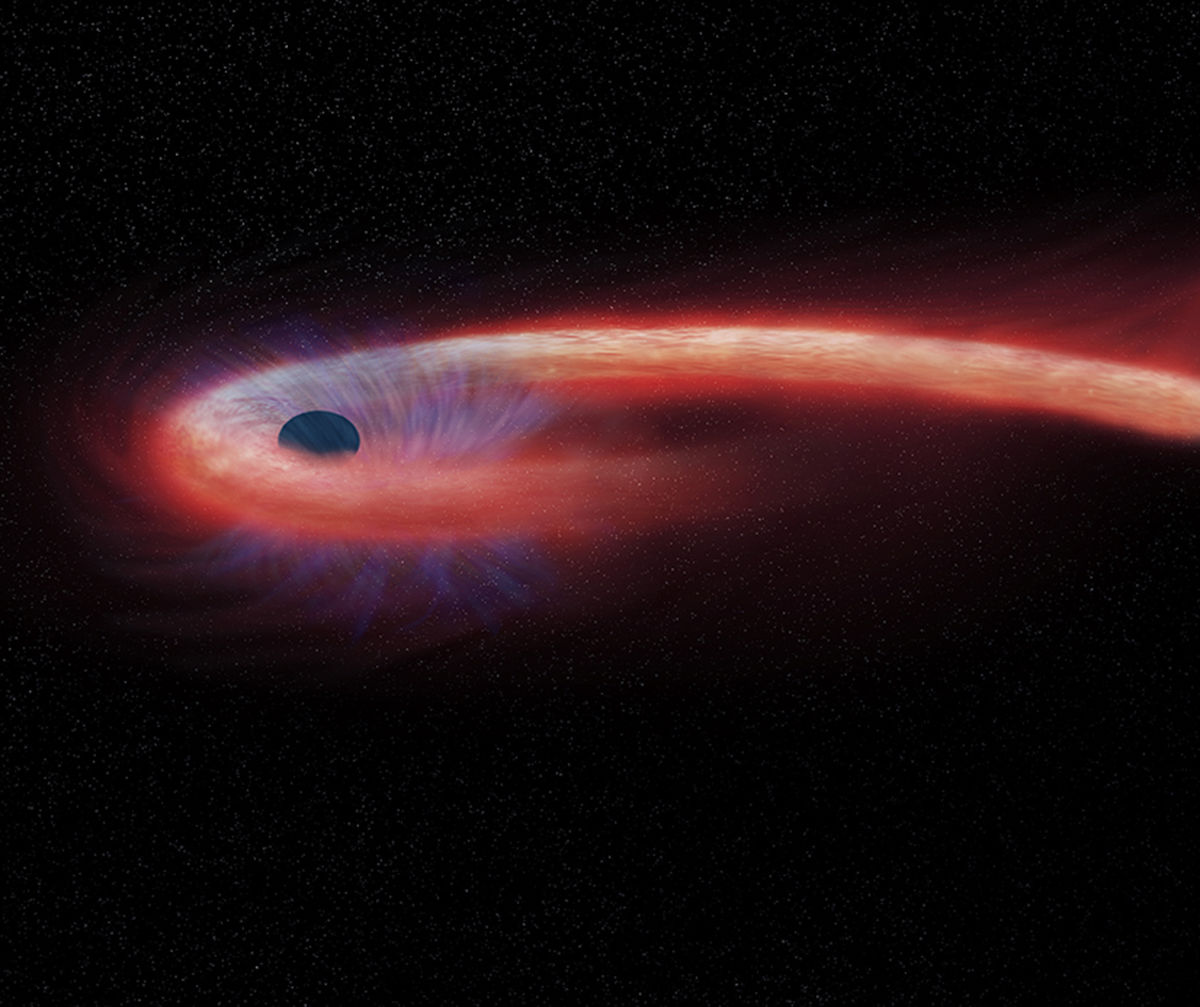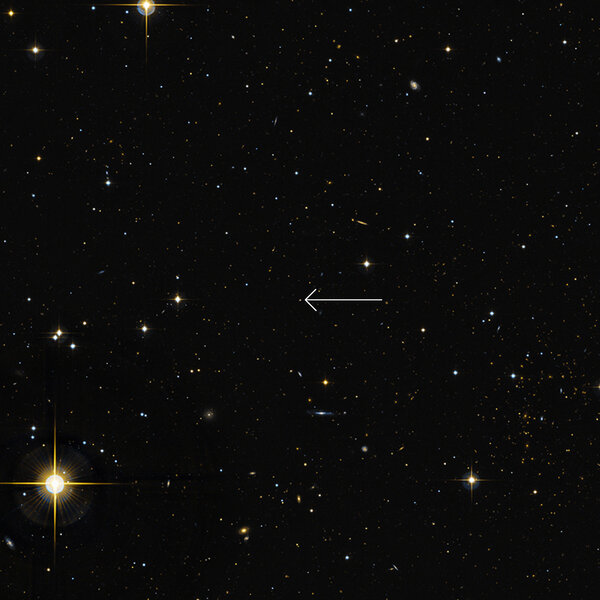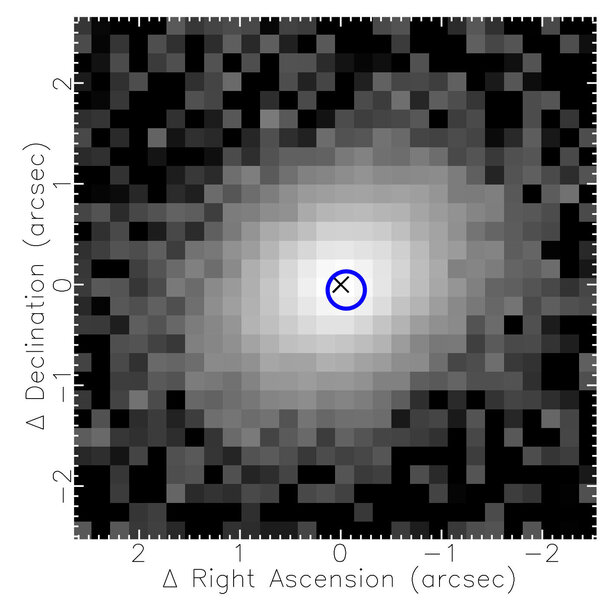Create a free profile to get unlimited access to exclusive videos, sweepstakes, and more!
A black hole in a distant galaxy has been eating a star… for more than a *decade*!

In a distant galaxy, a staggering 1.8 billion light years from Earth, a black hole is eating a star.
This is a colossal, titanic event; the gravity from the black hole literally rips the star apart and consumes the entrails, generating soul-vaporizing amounts of energy in the process. We’ve seen this sort of thing before, many times in fact… but this one is special. This black hole has been savoring its meal, munching away at the star for well over a decade.
The galaxy is prosaically called 3XMM J150052.0+015452 (let’s call it J150052 for short). It’s a dwarf galaxy, much smaller than the Milky Way, with a total mass of about 6 billion times the Sun’s (the Milky Way’s mass is over 100 times larger). It’s a starburst galaxy, meaning it’s not only actively making stars, but doing so quite vigorously.
Other than that, it never would’ve been noticed were it not for an accident of geometry: It coincidentally lies in the sky near to the position of NGC 5813, a much closer galaxy to us that happens to be of scientific interest. Scientists used the Chandra X-Ray Observatory to observe NGC 5813 many times over the years, and J150052 happens to be in the same field of view.
Astronomers noticed that J150052 was a decent source of X-rays — high-energy light generated in typically very violent, high-energy events. But it was weird: In April of 2005 it wasn’t even detectable in X-rays, but then in July of that same year it was booming them out. It continued to blast out X-rays for the next 11 years (at least; the last observations were in 2016 and it was still going strong) of Chandra observations, only dropping in brightness by a small amount.
Clearly, this was due to some very sudden event, one that is extremely powerful but then takes a long time to fade. The usual sort of exploding star can’t do that (they tend to fade within weeks or months), nor can most other X-ray-generating events.
We’ve seen events like these before, when a star wanders too closer to a black hole. Unlike in the movies, things don’t just fall in to black holes. The force of gravity, you may recall, depends on how far you are from an object. It gets stronger the closer you get.
A star is big and a black hole is small. As a star approaches a black hole, the near side of the star may be significantly closer to the black hole than the far side of the star. The gravity it feels from the black hole can change so much that the star feels a stretching force, what we call a tidal force. If this gets sufficiently powerful — and oh my, it certainly can — the gravity from the black hole can start to pull material off the star, and then eventually stretch it so much the star starts to get torn apart.
The terrifyingly violent and energetic nature of this event is hard to overstate. Stars are big. They are also hot, and generate lots of energy, which they slowly leak out over the course of billions of years.
When you tear a star to shreds, that energy is released immediately, and very rapidly, over the course of a year or two. Even a star like the Sun would blast out supernova-levels of energy if this were to happen to it, frying everything within dozens of light years and easily being detectable across a large fraction of the observable Universe.
So of course astronomers, in their attempt to mundanify everything, call this a tidal disruption event. If that’s still too exciting you can just call them TDEs.
That’s what happened in J150052. Observations of the X-rays generated indicate the event happened very close to the center of the galaxy, meaning it’s almost certainly due to the central supermassive black hole there (every big galaxy, including ours, has one). These can be incredibly huge black holes, scaling more or less with the mass of the galaxy hosting them. In the case of J150052, it’s probably something like 1-2 million times the Sun’s mass. Decently big.
The star is — um, was — about twice the mass of the Sun. That’s unusually large for such an event. Most of the TDEs observed before have been from smaller stars. More massive stars don’t live as long, so it makes sense an event like this with a massive star would be rare, probably 1% as common as low mass TDEs. It only happened at all because J150052 is actively making stars, so higher mass stars are available for consumption.
What makes this one so weird is how long it’s been going on. The usual TDE takes a year or two to fade; the one in J150052 has been ongoing since 2005! That’s why astronomers think the star must be massive; a smaller one would’ve been torn apart pretty rapidly.
Where are the X-rays coming from? As the star is disrupted, matter falls in a stream toward the black hole. But the approach is almost never head-on, instead there’s some sideways motion. This makes the stream circle around the black hole, forming a disk of gas around it. That material is extremely hot, and glows in X-rays. It also blasts incoming material with energy too, slowing it down, and in some cases giving it so much energy that some material flows away in a wind. This all affects the way X-rays are emitted, and astronomers have seen these signs in the observations, which is why they’re confident of what they see.
This is important work, because it ties in with a mystery that’s been plaguing astronomers for years. When we look at the very distant Universe, at galaxies that are very young, they seem to have fully grown black holes in them, some with masses billions of times the Sun’s. The problem is it’s hard to see how they could grow that large in such a short time, just a few hundred million years after the Big Bang itself.
These observations of a smaller and much closer black hole may help astronomers figure that out. There’s a limit to how fast black holes can eat as the material falling in heats up and affects material farther out, blowing it away. Turbulence in the gas, magnetic fields, and other effects may ease that limit, allowing the black hole to gobble down material faster than expected. If true, that can help those monster baby black holes grow to enormous size in short time, easing that issue.
Or maybe not. We still have a lot to learn and understand about these weird, voracious star killers, and what can affect their diet. The only way to figure this out is to find more events like this one. Given that the ill-fated star in J150052 was found by accident, perhaps many more such events have already been seen, hidden in data already taken. Hopefully we’ll be seeing quite a few more of these as time goes on.

















